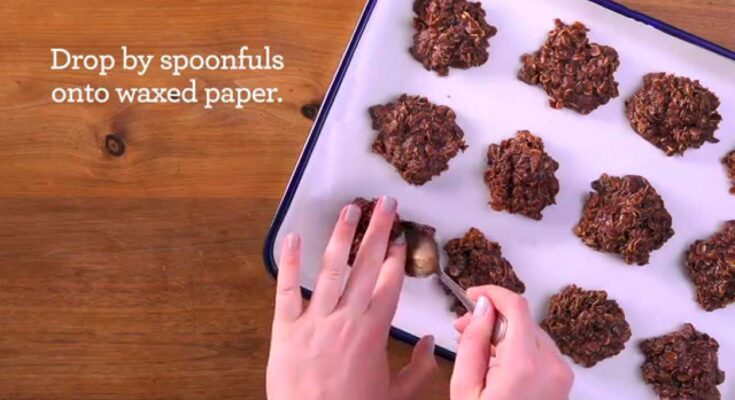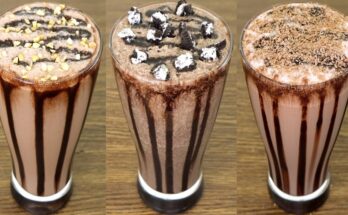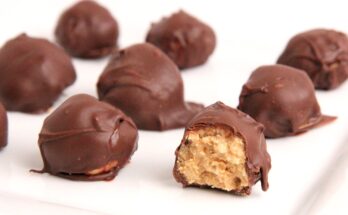Quaker Oats Oatmeal Cookie Recipe: Few desserts carry the comforting nostalgia of a warm, chewy oatmeal cookie. For generations, Quaker Oats has been a household name—bringing that familiar wholesome flavor to kitchens across the globe. Their classic oatmeal cookie recipe is not only easy to follow but also endlessly customizable to suit your taste buds. Whether you’re baking for family gatherings, prepping snacks for the week, or just craving a cozy treat, this recipe delivers the perfect balance of chewiness, sweetness, and oat-y goodness.
But why oatmeal cookies, you ask? Unlike many sugary treats, oatmeal cookies come with a dose of fiber and a rustic, hearty texture that elevates them from the typical cookie crowd. They’re incredibly satisfying—soft in the center with a slight crisp around the edges—and they carry a depth of flavor that rivals even the best chocolate chip cookies.
This guide will walk you through every step of making Quaker Oats oatmeal cookies, from gathering ingredients to the final golden-brown bake. Plus, we’ll toss in tips, variations, and a few baking secrets along the way. Ready to channel your inner cookie connoisseur? Let’s get baking!
Ingredients You’ll Need
Before you start mixing and measuring, make sure you’ve got all the necessary ingredients. These pantry staples are easy to find, and once combined, they create something magical.
Dry Ingredients
Here’s what you’ll need for the dry base:
- 1 1/2 cups of all-purpose flour – This gives your cookies structure.
- 1/2 teaspoon of baking soda – Helps them rise just right.
- 1/2 teaspoon of salt – Enhances the flavors.
- 1 teaspoon of cinnamon (optional) – Adds warmth and a cozy depth.
But the star of the show?
- 3 cups of Quaker Old-Fashioned Oats – These provide that chewy, textured bite. Avoid using instant oats—they tend to get too mushy when baked.
Wet Ingredients
Your wet mix is where the richness and sweetness come into play:
- 1 cup (2 sticks) of unsalted butter, softened – For that buttery mouthfeel.
- 1 cup of brown sugar, packed – Gives cookies their moisture and that classic molasses flavor.
- 1/2 cup of granulated sugar – Balances the brown sugar.
- 2 large eggs – Binds everything together.
- 1 teaspoon of vanilla extract – A little splash of aromatic magic.
Optional Add-Ins
Want to elevate your cookies? These extras add personality and extra taste:
- 1 cup of raisins or dried cranberries
- 1 cup of chocolate chips (milk, dark, or white)
- 1/2 cup of chopped nuts (walnuts or pecans)
Mix and match to suit your style. Whether you’re team raisin or a chocolate lover, the possibilities are deliciously endless.
Tools and Equipment Required
You don’t need fancy gadgets to whip up a batch of oatmeal cookies, but having the right tools makes the process smoother and more enjoyable.
Mixing Essentials
- Large Mixing Bowl – For combining your dough.
- Medium Bowl – Ideal for dry ingredients.
- Electric Mixer or Hand Mixer – Makes creaming the butter and sugar easier.
- Measuring Cups and Spoons – Accuracy is key in baking.
Baking Tools
- Baking Sheets – At least two, so you can rotate batches.
- Parchment Paper or Silicone Baking Mats – For non-stick and easy cleanup.
- Cookie Scoop or Tablespoon – For evenly sized cookies.
- Cooling Rack – Helps cookies firm up after baking.
Having these items prepped and ready before you begin baking keeps your workflow smooth—and your kitchen chaos-free.
How to Make Quaker Oats Oatmeal Cookie – Step-by-Step Instructions
Alright, the fun part begins now. Follow these simple, foolproof steps to create the best oatmeal cookies you’ve ever tasted.
Step 1 – Preheat Your Oven
Set your oven to 350°F (175°C). This is the ideal temperature for baking cookies that are slightly crisp on the outside and perfectly chewy on the inside. Make sure your oven rack is in the middle position for even baking. While the oven heats, line your baking sheets with parchment paper or silicone mats to prevent sticking.
Step 2 – Prepare the Wet Ingredients
In a large mixing bowl, cream together the butter, brown sugar, and granulated sugar until light and fluffy. This takes about 2–3 minutes with an electric mixer on medium speed.
Next, add the eggs one at a time, beating well after each addition. This helps with the texture and structure of your cookies. Finally, stir in the vanilla extract, which adds a rich flavor foundation to the dough.
This wet mixture should now be creamy, smooth, and fragrant. It forms the base that will hold your oats and flour together in perfect harmony.
Step 3 – Mix the Dry Ingredients
In a separate bowl, whisk together the flour, baking soda, salt, and cinnamon. Doing this in a separate bowl ensures even distribution of the leavening agents, which helps the cookies bake uniformly.
Then, stir in the Quaker Oats. If you’re using old-fashioned oats, you’ll get that beautiful chewiness oatmeal cookies are known for. Your dry mixture should be hearty and well-blended—ready to marry the wet ingredients for cookie perfection.
Step 4 – Combine Wet and Dry Mixes
Now comes the real transformation. Slowly add the dry ingredients to the wet mixture in batches—don’t dump it all in at once. Mix on low speed (or by hand with a wooden spoon) until everything is just combined. Overmixing here can lead to tough cookies, and nobody wants that.
You’ll notice the dough becoming thicker and slightly sticky. That’s exactly what you want. This is the stage where the oats start to absorb moisture from the wet ingredients, which will result in that signature chewy texture once baked.
Once everything is fully mixed, give the dough a gentle stir to ensure there are no dry flour patches lurking at the bottom of the bowl.
Step 5 – Add Optional Ingredients (Chocolate Chips, Raisins, etc.)
This is your moment to get creative. Whether you’re a fan of classic raisin oatmeal cookies or want to spice things up with chocolate chips, this is where you make the dough your own.
Stir in your chosen add-ins gently:
- Chocolate chips melt into gooey pools of happiness.
- Raisins give that chewy, sweet tang.
- Chopped nuts bring a lovely crunch and earthiness.
Use about 1 to 1.5 cups of mix-ins total. Too much, and your cookies might fall apart; too little, and you’ll miss out on that extra flavor burst.
You can even divide the dough in half and create two different cookie flavors from one batch. Genius, right?
Step 6 – Scoop and Shape the Dough
Grab your cookie scoop or a heaping tablespoon and begin dropping balls of dough onto your prepared baking sheets. Space them about 2 inches apart, as they will spread a little while baking.
If you like thicker cookies, chill the dough in the fridge for 20–30 minutes before baking. Chilled dough spreads less, resulting in a denser, chewier cookie. If you’re in a hurry, you can skip this step and still get great results, though your cookies may be slightly flatter.
Pro tip: Gently press the tops of each cookie dough ball with the back of your spoon. This gives the cookies that signature rustic look and helps them bake evenly.
Step 7 – Bake to Perfection
Pop your tray into the preheated oven and bake for 10 to 12 minutes. You’re looking for golden edges with a soft center—they might even look a little underdone in the middle when you take them out, but that’s a good thing.
Cookies continue to bake on the hot tray even after they’re out of the oven, so resist the urge to overbake. Let them cool on the tray for about 5 minutes, then transfer to a cooling rack.
That’s it—you’ve just made the ultimate batch of homemade Quaker Oats oatmeal cookies!
Tips for the Best Quaker Oatmeal Cookies
Even though this recipe is pretty straightforward, a few insider tips can elevate your cookies from great to unforgettable.
- Use room-temperature ingredients – This ensures everything blends more smoothly.
- Cream the butter and sugar properly – Don’t rush this step. It adds air to your dough, resulting in lighter cookies.
- Chill the dough – Especially in warmer climates, this helps prevent spreading.
- Don’t overbake – Golden edges and a soft center are the cookie sweet spot.
- Experiment with textures – Use a mix of oats (some quick oats, some old-fashioned) for added depth.
One final tip? Double the batch. These cookies tend to disappear faster than you think!
Storing and Preserving Your Cookies
So, you’ve baked a big batch of mouthwatering oatmeal cookies—now the big question: how do you keep them fresh and delicious for as long as possible?
Short-Term Storage
For cookies that will be devoured within a few days (which is usually the case!), store them in an airtight container at room temperature. They’ll stay fresh for up to 5 days. Here’s how to do it right:
- Use parchment paper between layers – This prevents them from sticking together.
- Add a slice of bread – Yep, just one slice of white bread in the container can keep cookies soft for days. The bread will dry out, not the cookies.
Long-Term Storage
Want to make them last longer? The freezer is your best friend:
- Freezing baked cookies: Once cooled completely, place the cookies in a single layer on a baking sheet and freeze until solid. Then transfer to a freezer-safe bag or container. They’ll last for up to 3 months.
- Freezing cookie dough: Roll the dough into balls, freeze on a baking sheet, and store in a zip-top freezer bag. You can bake straight from the freezer—just add 1–2 minutes to the bake time.
Having frozen cookie dough on hand is like having a dessert emergency kit. Bad day? Bake two cookies. Unexpected guests? Bake ten. It’s foolproof cookie therapy.
Nutritional Information
Oatmeal cookies taste great, but they also have a bit of a health edge—thanks to those fiber-packed oats. Here’s a rough breakdown for one medium-sized cookie (based on the classic recipe without add-ins):
| Nutrient | Amount |
|---|---|
| Calories | 130–150 |
| Total Fat | 6g |
| Saturated Fat | 3g |
| Carbohydrates | 20g |
| Sugars | 10g |
| Fiber | 1.5g |
| Protein | 2g |
Add-ins like chocolate chips, nuts, or dried fruit will slightly increase the calorie and sugar count, but hey—it’s a treat!
Want a lighter version? Try swapping half the butter for applesauce, or use coconut sugar and whole wheat flour for a healthier spin.
Variations You Can Try
Once you’ve mastered the base recipe, it’s time to have some fun. The beauty of oatmeal cookies is how versatile they are—you can customize them for any craving or dietary need.
Chocolate Chip Oatmeal Cookies
Swap out the raisins for chocolate chips (or add both if you’re feeling wild). Use dark chocolate for a more grown-up flavor or white chocolate for something extra sweet. You can also sprinkle a pinch of sea salt on top before baking for that sweet-and-salty balance.
Peanut Butter Oatmeal Cookies
Add 1/2 cup of creamy peanut butter to the wet mix for a nutty twist. These cookies are incredibly rich and flavorful. Optional: stir in chocolate chips or chopped peanuts for texture.
Vegan Oatmeal Cookies
No eggs? No problem. Replace each egg with a “flax egg” (1 tablespoon ground flaxseed + 3 tablespoons water, let sit 5 minutes). Use vegan butter or coconut oil in place of regular butter. These cookies still come out chewy and delicious—perfect for plant-based eaters.
Feeling adventurous? Try adding shredded coconut, dried cherries, pumpkin spice, or even crushed pretzels. The only rule here is to follow your cravings.
FAQs about Quaker Oats Oatmeal Cookie Recipe
1. Can I use quick oats instead of old-fashioned oats?
Yes, you can substitute quick oats for old-fashioned oats. However, old-fashioned oats give the cookies a chewier texture, while quick oats result in a softer, more delicate bite.
2. Do I need to chill the cookie dough before baking?
Chilling the dough is optional, but highly recommended. It helps the cookies hold their shape and enhances the flavor by allowing the ingredients to meld.
3. Can I add raisins or chocolate chips?
Absolutely! Raisins, chocolate chips, or even chopped nuts are popular add-ins to customize your Quaker Oats oatmeal cookies.
4. How do I store oatmeal cookies?
Store your cookies in an airtight container at room temperature for up to a week. For longer freshness, freeze them for up to 3 months.
5. Are Quaker Oats oatmeal cookies healthy?
While they do contain oats—which are a good source of fiber—oatmeal cookies often include sugar and butter. For a healthier version, consider reducing sugar or using healthier fat alternatives like coconut oil.
Conclusion
There’s something incredibly satisfying about baking your own batch of Quaker Oats oatmeal cookies. They’re nostalgic, easy to make, and adaptable to any taste. Whether you’re going classic with raisins or spicing things up with chocolate and nuts, this is one recipe you’ll come back to again and again.
The best part? You don’t need fancy ingredients or special skills. Just some oats, a few basics, and a love for all things cookie. So next time you want to fill your home with that warm, buttery aroma—grab your oats and get baking. Happy cookie-making!



